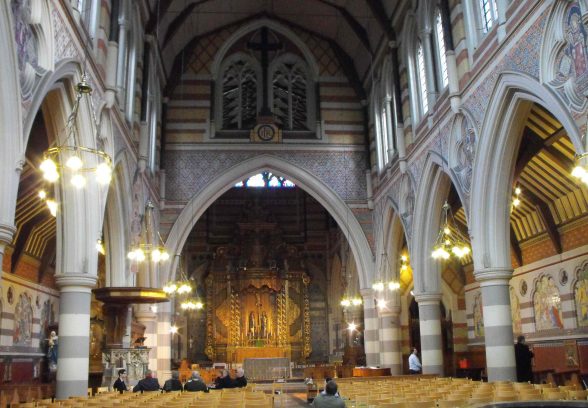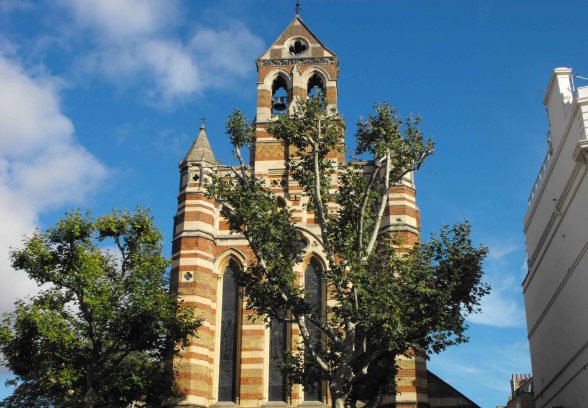This website uses cookies
This website uses cookies to enable it to function properly and to analyse how the website is used. Please click 'Close' to accept and continue using the website.




Widely appreciated as probably the second-best surviving church in London by William Butterfield, St Augustine’s church at Queen’s Gate, Kensington hides a special surprise for C20 fans. Alterations and re- ordering in the late 1920s and then post- war repairs resulted in some impressive church fittings linked to a movement retrospectively dubbed ‘Back to Baroque’ . The immense reredos and altarpiece, the backdrop and tester for Butterfield’s pulpit, the Stations of the Cross and the Lady Chapel altar and triptych in the north aisle, are all very distinguished interventions by Howard Martin Otho Travers (1886-1948).
Travers was one of the twentieth century’s leading designers of church furnishings and stained glass, and is best known as the leading exponent of the Back to Baroque movement in Anglo- Catholic liturgy and design, popular in the inter-war period under the auspices of the Society of SS Peter and Paul (SSPP). As a draughtsman, Travers is perhaps best known for his illustrations for the booklets and cards published by the SSPP. Although he was not a member of the RIBA, in the late 1920s and early 1930s he became involved in the construction of complete churches. Travers was one of the finest designers of the period and his contribution to the Back to Baroque tradition is comparable to that of Sir John Ninian Comper (1864-1960) to a late phase of the Gothic Revival.
Travers’s approach to church furnishings has been distinctively characterised by a strong ‘theatricality’ , and his work for St Augustine’s church is most typically in this idiom. Here, design principles and elements reminiscent of the Baroque are ingeniously elevated to new heights in their Counter- Reformation extravagance, and, whatever one’s personal stylistic preferences may be, they are highly significant to this particular phase in twentieth century church design history.
The reredos in particular are very original, and widely considered to be Travers’s most accomplished work. Despite their rather flat nature, their design allows them to appear more three-dimensional than they actually are. Their colouring is also very subtle, as Travers had the wood covered with silver foil and then varnished over with gold tints. The realised scheme was the third version designed by Travers and much more ‘adventurous’ than earlier work: reminiscent of South American Baroque but with a distinctive Deco quality that is strongly of its own time, the 1920s. The imitation of pleated material on the two side panels, for example, bears a certain resemblance to curtain drapes found in cinemas of the period.
From its earliest days, even before the church was built, the parish of St Augustine’s has had an Anglo-Catholic tradition, and Travers’s approach, closely associated with the SSPP, commemorates the significant part played by this church in the Anglo-Catholic Congress Movement. It constitutes a very substantial and skilful architectural expression of this key period of the Church of England.
The SSPP was formed on 24 February 1911, largely as a progressive reaction to the earlier formation of the ‘Alcuin Club’ , which aimed to promote the Church’s return to the beliefs and customs of the late middle ages. Some of the most prominent churchmen of the day-including Ronald Knox-joined the SSPP movement. The two groups competed for a number of years, as is clearly reflected in their publications. The Alcuin Club’s Illustrations to the Liturgy (1916) was followed four years later by the SSPP’s Pictures of the English Liturgy- Low Mass. Travers illustrated this and also a 1922 companion volume, providing SSPP with an alternative visual expression that drew on the traditions of Baroque and Rococo, rather than medievalism.
Another well-known example of Travers’s work is that for St Mary’s Church, Bourne Street, Pimlico. This project played a key role in the development of Travers’s practice and is considered to embody the ideals of the SSPP. The church was initially listed at Grade II in 1970 but last year was upgraded to Grade II*. In the revised listing description, Travers’s fittings are included in the reasons for designation. Other principal works by Travers in London can be found at St Saviour in Hoxton, Wren’s St Magnus Martyr in the City of London, Holy Trinity in New Barnet and St Matthew in Westminster.
There have been suggestions for a return to St Augustine’s initial form, but the Society strongly believes that the 1928- 30 alterations and re-ordering, together with the post-war repairs, constitute integral parts of the church’s architectural evolution. Travers’s subsequent contributions to Butterfield’s building have added to the building’s significance rather than detracting from it, and the Society’s position has in the past been taken by some of the most notable and knowledgeable figures in British architectural history and conservation. John Betjeman and Nikolaus Pevsner were President and Vice-President of the restoration appeal committee which was active around 1974. In the appeal brochure, Betjeman specifically noted that the restoration and redecoration proposals would be expected to respect the work of both William Butterfield and Martin Travers. In his Collins Pocket Guide to English Parish Churches (1958), Betjeman further described Travers’s work for St Augustine’s as ‘the apotheosis of the Anglo-Catholic Congress movement’ and ‘a period piece of rare delight’ . In Victorian Buildings in London 1837-1887 (1980), Gavin Stamp and Colin Amery argue that Travers’s fittings are ‘just as worthy of preservation in their own right [as Butterfield’s work]’ . Precisely for these reasons, the upgrade of the Grade II* building to Grade I should perhaps be considered.
The Society has long been committed to Travers’s work, with visits in 1992 and 2003 to both St Mary’s, Bourne Street and St Augustine’s. It was also our 2008 application, jointly with the Victorian Society, that led to the upgrade of St Mary’s to Grade II*. As we go to press, changes can be foreseen in St Augustine’s immediate future. A church planting is at present being planned by Holy Trinity Brompton and, rather unsurprisingly, the removal of Travers’s reredos and the pulpit’s backdrop and setting were included in a long list of pre-application proposals. The Society attended an on-site visit organised by the London Diocesan Advisory Committee and has since made representations strongly defending Travers’s work. We have argued that, though of a completely different style, it is complementary to Butterfield’s original design. We hope that our comments will be taken into consideration and that these delicate survivals of a very particular period in church and design history will remain safely in situ for many years to come.
Christina Malathouni

Become a C20 member today and help save our modern design heritage.